Study of Fe:ZnSe Laser Exited by Diode Side-Pumped Er:YAG Laser
Abstract
:1. Introduction
2. Materials and Methods
3. Results
3.1. Experimental Results
3.2. Simulation of Experimental Results
4. Conclusions
Author Contributions
Funding
Institutional Review Board Statement
Informed Consent Statement
Data Availability Statement
Acknowledgments
Conflicts of Interest
References
- Adams, J.J.; Bibeau, C.; Page, R.H.; Krol, D.M.; Furu, L.H.; Payne, S.A. 4.0–4.5 μm lasing of Fe: ZnSe below 180 K, a new mid-infrared laser material. Opt. Lett. 2000, 24, 1720–1722. [Google Scholar] [CrossRef] [PubMed]
- Mirov, S.B.; Moskalev, I.S.; Vasilyev, S.; Smolski, V.; Fedorov, V.V.; Martyshkin, D.; Peppers, J.; Mirov, M.; Dergachev, A.; Gapontsev, V. Frontiers of mid-IR lasers based on transition metal doped chalcogenides. IEEE J. Sel. Top. Quantum Electron. 2018, 24, 1601829. [Google Scholar] [CrossRef]
- Fedorov, V.V.; Mirov, S.B.; Gallian, A.; Badikov, D.V.; Frolov, M.P.; Korostelin, Y.V.; Kozlovsky, V.I.; Landman, A.I.; Podmar’kov, Y.P.; Akimov, V.A.; et al. 3.77–5.05-µm Tunable Solid-State Lasers Based on Fe2+-Doped ZnSe Crystals Operating at Low and Room Temperatures. IEEE J. Quantum Electron. 2006, 42, 907. [Google Scholar] [CrossRef]
- Kozlovsky, V.I.; Korostelin, Y.V.; Podmar’kov, Y.P.; Skasyrsky, Y.K.; Frolov, M.P. Middle infrared Fe2+:ZnS, Fe2+:ZnSe and Cr2+:CdSe lasers: New results. J. Phys. Conf. Ser. 2016, 740, 012006. [Google Scholar] [CrossRef]
- Voronov, A.A.E.; Kozlovskii, V.I.; Korostelin, Y.V.; Landman, A.I.; Podmar’Kov, Y.P.; Skasyrskii, Y.K.; Frolov, M.P. A continuous-wave Fe2+:ZnSe laser. Quantum Electron. 2008, 38, 1113–1116. [Google Scholar] [CrossRef]
- Vasilyev, S.; Moskalev, I.; Mirov, M.; Smolsky, V.; Martyshkin, D.; Fedorov, V.; Mirov, S.; Gapontsev, V. Progress in Cr and Fe doped ZnS/Se mid-IR CW and femtosecond lasers. Proc. SPIE 2017, 10193, 101930U. [Google Scholar] [CrossRef]
- Mirov, S.; Fedorov, V.; Martyshkin, D.; Moskalev, I.; Mirov, M.; Vasilyev, S. High average power Fe:ZnSe and Cr:ZnSe mid-IR solid state lasers. In Proceedings of the Advanced Solid State Lasers Conference 2015 (Optical Society of America 2015), Berlin, Germany, 4–9 October 2015; p. AW4A. [Google Scholar] [CrossRef]
- Pushikin, A.V.; Migal, E.A.; Tokita, S.; Korostelin, Y.V.; Potemkin, F.V. Femtosecond graphene mode-locked Fe:ZnSe laser at 4.4 µm. Opt. Lett. 2020, 45, 738. [Google Scholar] [CrossRef] [PubMed]
- Frolov, M.P.; Korostelin, Y.V.; Kozlovsky, V.I.; Skasyrsky, Y.K. Study of room-temperature, monocrystalline Fe:ZnSe laser, pumped by high-energy, free-running Er:YAG laser. Laser Phys. 2019, 29, 085004. [Google Scholar] [CrossRef]
- Akimov, V.A.; Voronov, A.A.E.; Kozlovskii, V.I.; Korostelin, Y.V.; Landman, A.I.; Podmar’kov, Y.P.; Frolov, M.P. Efficient lasing in a Fe2+:ZnSe crystal at room temperature. Quantum Electron. 2006, 36, 299–301. [Google Scholar] [CrossRef]
- Kozlovsky, V.I.; Korostelin, Y.V.; Skasyrsky, Y.K.; Frolov, M.P. Nanosecond room-temperature Fe:ZnSe laser pumped inside the resonator of a transversely diode-pumped Er:YLF laser. Quantum Electron. 2018, 48, 686. [Google Scholar] [CrossRef]
- Kozlovsky, V.I.; Frolov, M.P.; Korostelin, Y.V.; Skasyrsky, Y.K. Nanosecond-pulsed RT-operating at ~4 μm Fe:ZnSe laser pumped inside the cavity of a LD side-pumped Er:YLF laser. Opt. Express 2018, 26, 24497–24505. [Google Scholar] [CrossRef] [PubMed]
- Leonov, S.; Frolov, M.; Korostelin, Y.; Skasyrsky, Y.; Kozlovsky, V. Gain-switched Fe:ZnSe laser pumped by a coupled-cavity Q-switched Er:ZrF4 fiber laser. Opt. Lett. 2023, 48, 2957. [Google Scholar] [CrossRef] [PubMed]
- Kozlovsky, V.I.; Akimov, V.A.; Frolov, M.P.; Korostelin, Y.V.; Landman, A.I.; Martovitsky, V.P.; Mislavskii, V.V.; Podmar’kov, Y.P.; Skasyrsky, Y.K.; Voronov, A.A. Room-temperature tunable mid-infrared lasers on transition-metal doped II-VI compound crystals grown from vapour phase. Phys. Status Solidi B 2010, 247, 1553–1558. [Google Scholar] [CrossRef]
- Basiev, T.T.; Kharikov, E.V.; Zhekov, V.I.; Murina, T.M.; Osiko, V.V.; Prokhorov, A.M.; Starikov, B.P.; Timoshechkin, M.I.; Shcherbakov, I.A. Radiative and nonradiative transitions exhibited by Er3+ ions in mixed yttrium-erbium aluminum garnets. Sov. J. Quantum Electron. 1976, 6, 796. [Google Scholar] [CrossRef]
- Koetke, J.; Huber, G. Infrared excited-state absorption and stimulated-emission cross sections of Er3+-doped crystals. Appl. Phys. B 1995, 61, 151–158. [Google Scholar] [CrossRef]
- Zharikov, E.V.; Zhekov, V.I.; Murina, T.M.; Osiko, V.V.; Tomoshechkin, M.I.; Shcherbakov, I.A. Cross-section of the 4I11/2 → 4I13/2 laser transition in yttrium-erbium-aluminum garnet crystals. Sov. J. Quantum Electron. 1977, 7, 117–119. [Google Scholar] [CrossRef]
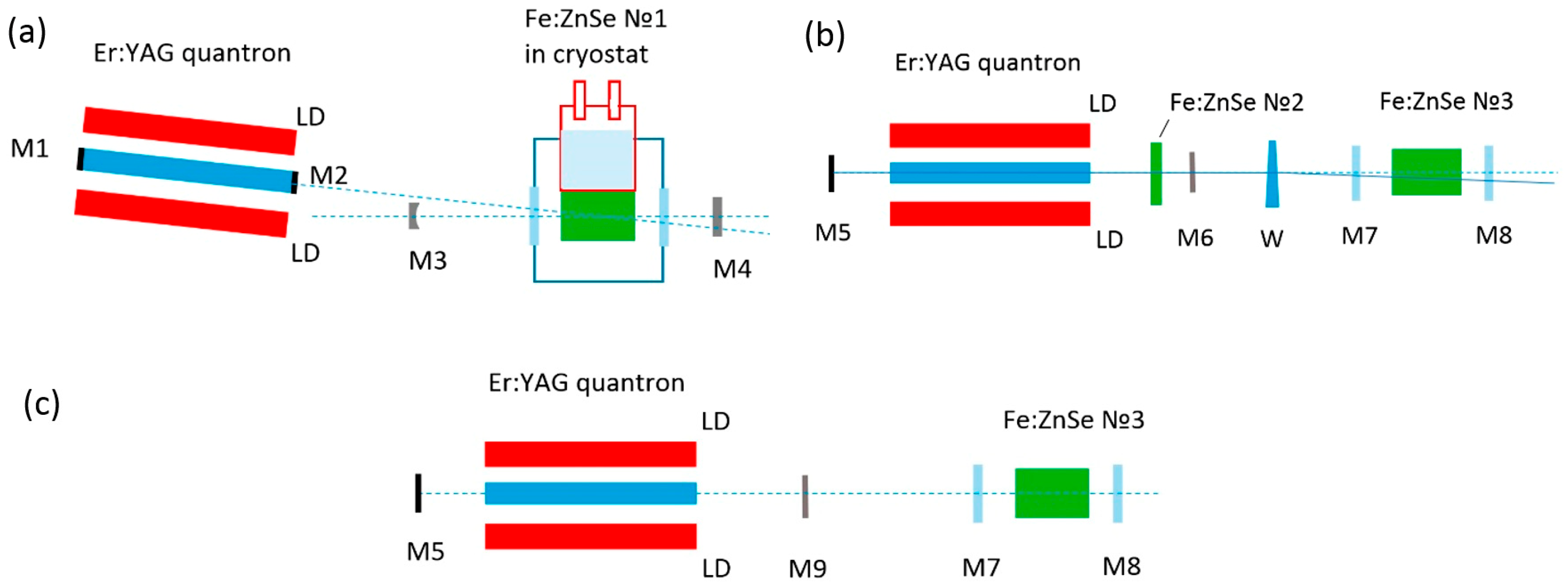
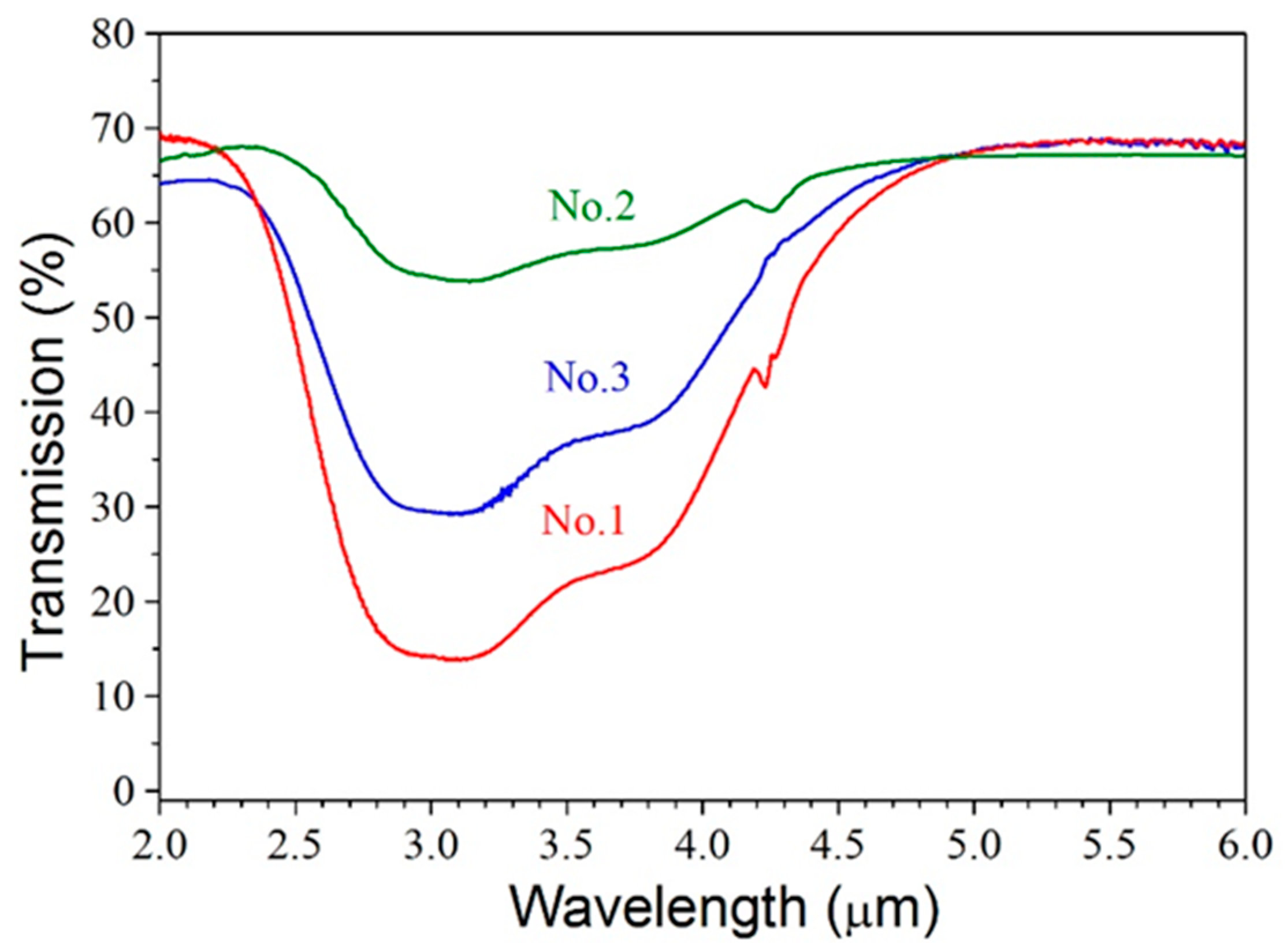
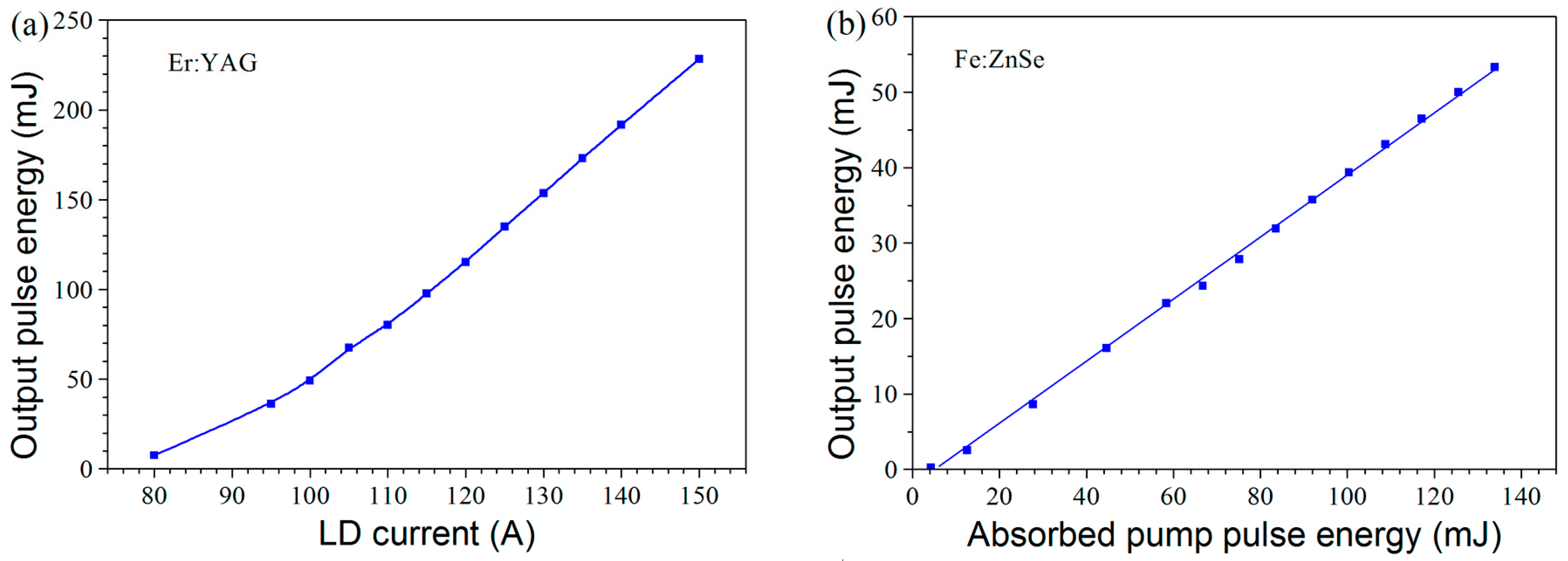

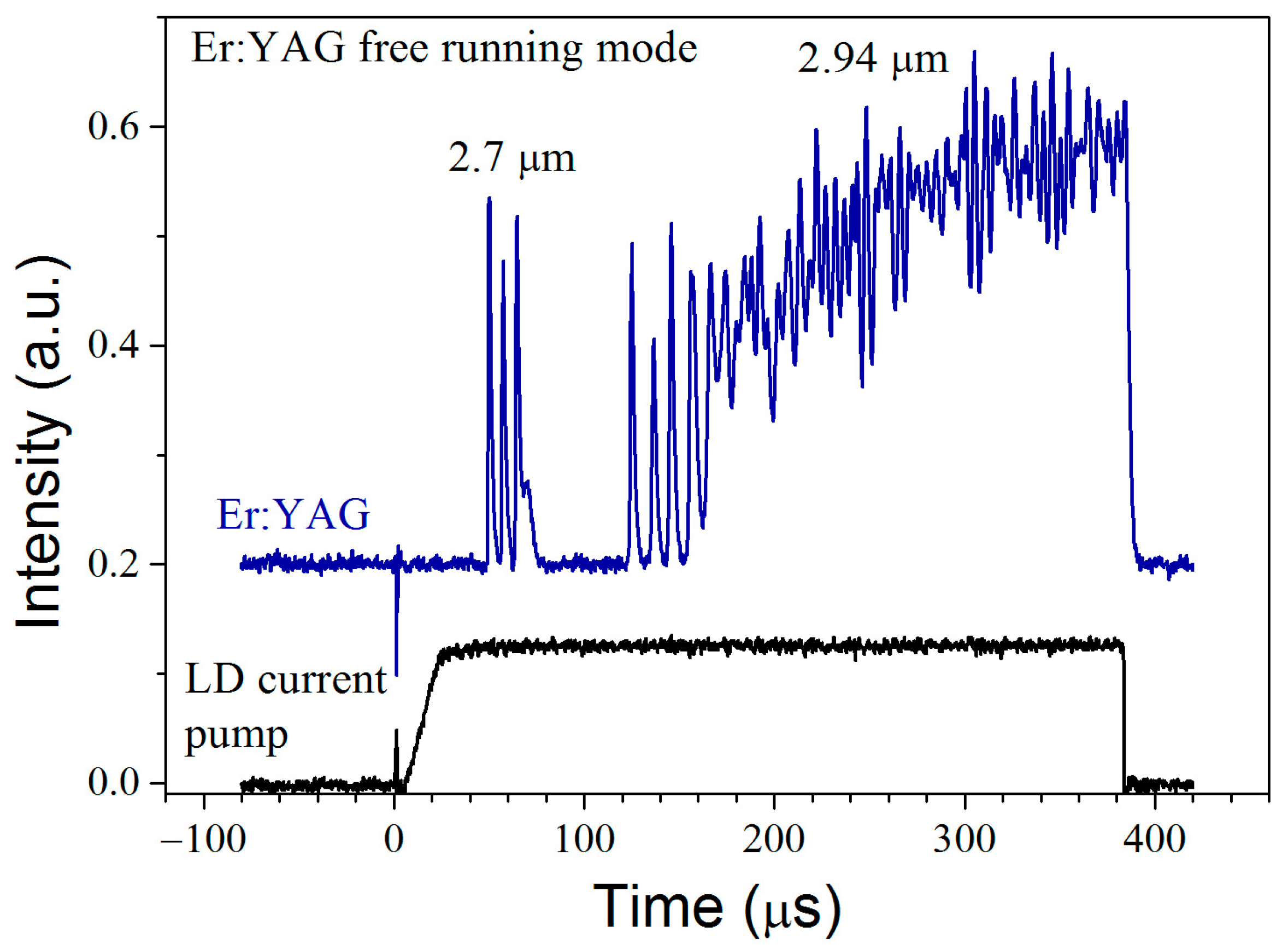
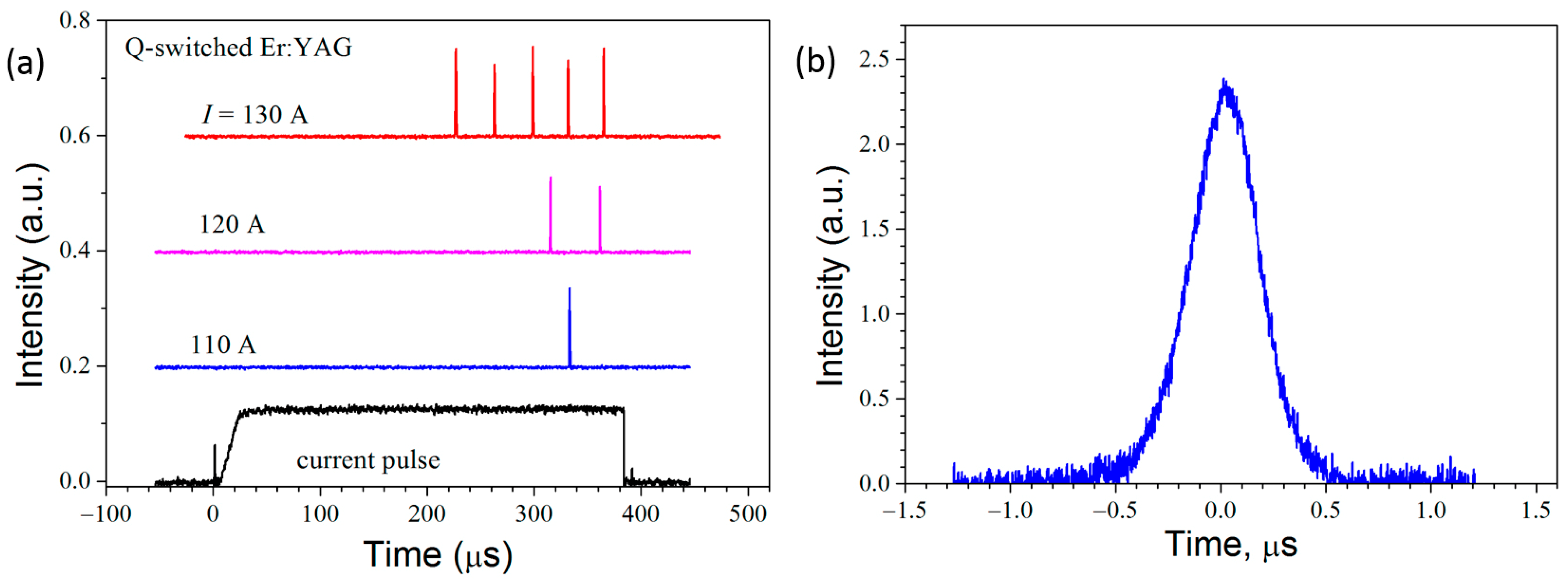

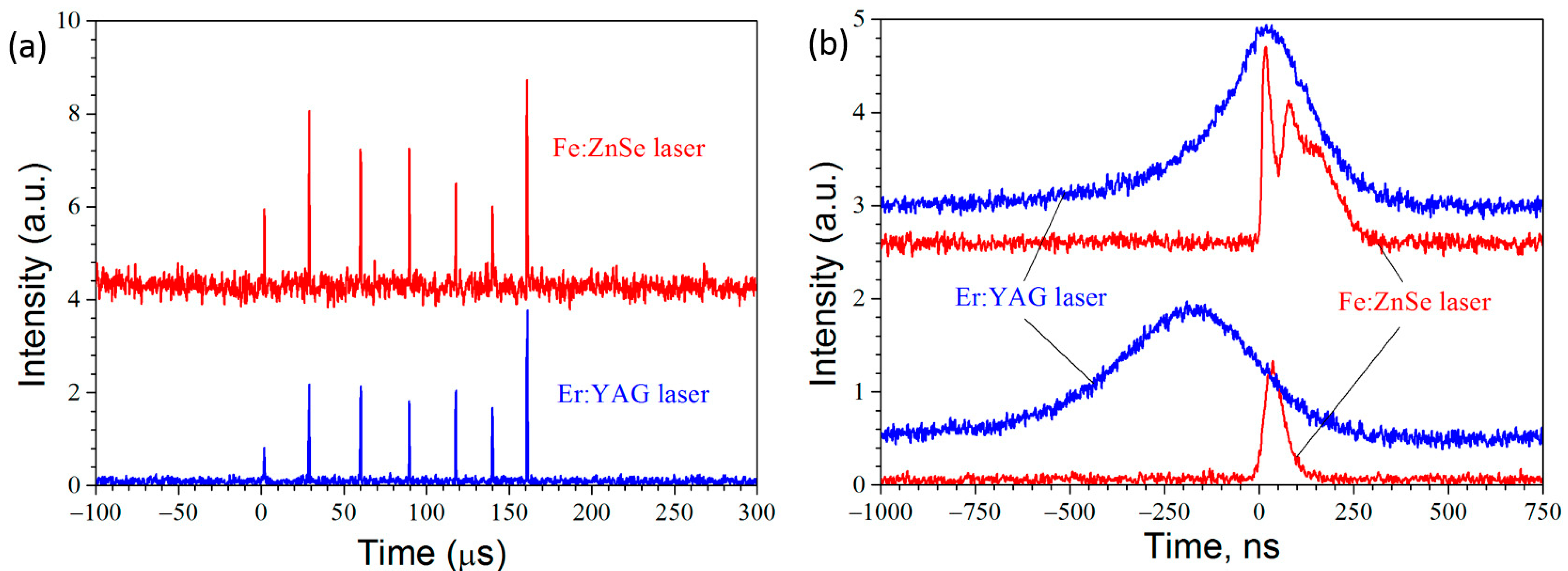


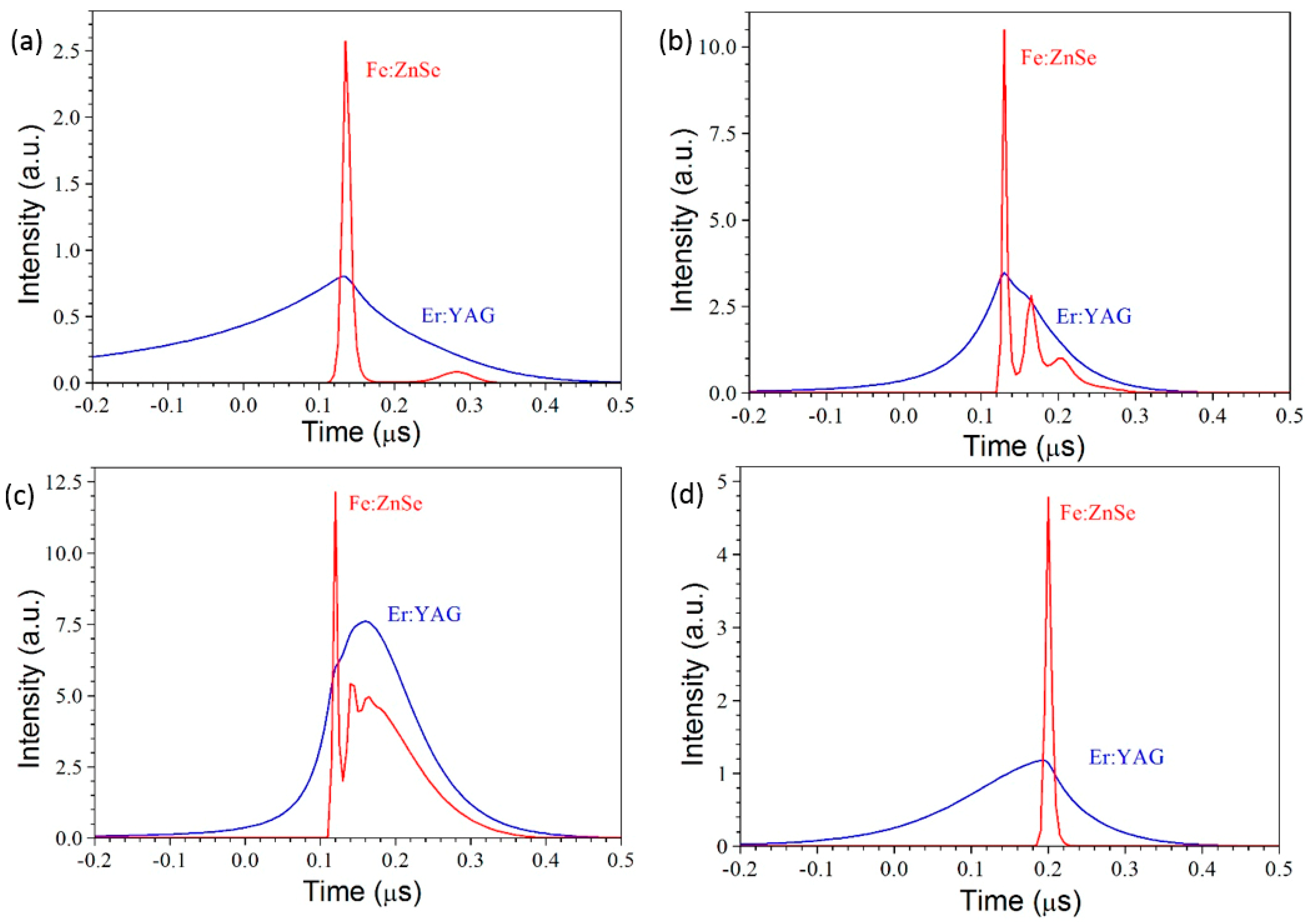
| Parameter | Description | Value |
|---|---|---|
| N1 | Concentration of excited Er ions | |
| N2 | Concentration of excited Fe ions | |
| N20 | Total concentration of Fe ions | 0.5 × 1018 cm−3 |
| ρ1 | Photon density in the Er:YAG laser resonator | |
| ρ2 | Photon density in the Fe:ZnSe laser resonator | |
| S1e | Emission cross section of Er ions | varies |
| S2a | Absorption cross section of Fe ions at 2.94 μm | 0.97 × 10−18 cm2 [2] |
| S2e | Emission cross section of Fe ions at 4.4 μm | 1.1 × 10−18 cm2 [2] |
| S2ea | Absorption cross section of Fe ions at 4.4 μm | 0.15 × 10−18 cm2 [9] |
| τ1 | The lifetime of the upper level of Er ions | 85 μs [15] |
| τ10 | The radiative lifetime of the upper level of Er ions | 5 ms [15] |
| τ2 | The lifetime of the upper level of Fe ions | 0.35 μs [2] |
| τ20 | The radiative lifetime of the upper level of Fe ions | 57 μs [2] |
| β1 | The spontaneous emission factor in the Er:YAG laser mode | 10−6 |
| β2 | The spontaneous emission factor in the Fe:ZnSe laser mode | 10−6 |
| c | Speed of light | 3 × 1010 cm/s |
| n1 | Er:YAG refractive index | 1.79 |
| n2 | Fe:ZnSe refractive index | 2.4 |
| P | Pumping power of laser diodes | varies |
| Photon energy of laser diode radiation | 1.3 eV | |
| Photon energy of Er:YAG laser radiation | 0.42 eV | |
| Photon energy of Fe:ZnSe laser radiation | 0.28 eV | |
| d | Diameter of Er:YAG rod | 4 mm |
| L1 | Length of Er:YAG rod | 100 mm |
| L2 | Length of Fe:ZnSe crystal | 16.4 mm |
| Lc1 | Resonator length of Er:YAG laser | 550 mm |
| Lc2 | Resonator length of Fe:ZnSe laser | 50 mm |
| α1 | Round-trip losses in Er:YAG laser resonator | 0.02 |
| α2 | Round-trip losses in Fe:ZnSe laser resonator | 0.25 |
| T1 | Coupling coefficient between resonators | 0.35 |
| T2 | Transmission of mirror M7 at 4.4 μm | 0.25 |
| t1 | Pump activation parameter | 50 μs |
| t0 | The steepness of the pumping front | 30 μs |
Disclaimer/Publisher’s Note: The statements, opinions and data contained in all publications are solely those of the individual author(s) and contributor(s) and not of MDPI and/or the editor(s). MDPI and/or the editor(s) disclaim responsibility for any injury to people or property resulting from any ideas, methods, instructions or products referred to in the content. |
© 2023 by the authors. Licensee MDPI, Basel, Switzerland. This article is an open access article distributed under the terms and conditions of the Creative Commons Attribution (CC BY) license (https://creativecommons.org/licenses/by/4.0/).
Share and Cite
Kozlovsky, V.; Butaev, M.; Korostelin, Y.; Leonov, S.; Skasyrsky, Y.; Frolov, M. Study of Fe:ZnSe Laser Exited by Diode Side-Pumped Er:YAG Laser. Photonics 2023, 10, 869. https://doi.org/10.3390/photonics10080869
Kozlovsky V, Butaev M, Korostelin Y, Leonov S, Skasyrsky Y, Frolov M. Study of Fe:ZnSe Laser Exited by Diode Side-Pumped Er:YAG Laser. Photonics. 2023; 10(8):869. https://doi.org/10.3390/photonics10080869
Chicago/Turabian StyleKozlovsky, Vladimir, Marat Butaev, Yury Korostelin, Stanislav Leonov, Yan Skasyrsky, and Mikhail Frolov. 2023. "Study of Fe:ZnSe Laser Exited by Diode Side-Pumped Er:YAG Laser" Photonics 10, no. 8: 869. https://doi.org/10.3390/photonics10080869
APA StyleKozlovsky, V., Butaev, M., Korostelin, Y., Leonov, S., Skasyrsky, Y., & Frolov, M. (2023). Study of Fe:ZnSe Laser Exited by Diode Side-Pumped Er:YAG Laser. Photonics, 10(8), 869. https://doi.org/10.3390/photonics10080869




